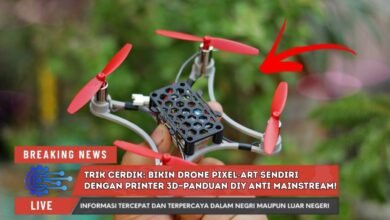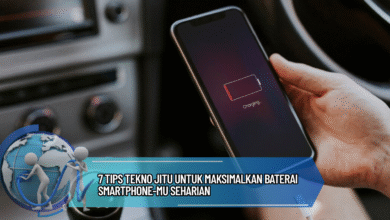PC Low-End Bertahan di 2025: Trik Ampuh Pakai RAM Virtual dari SSD PCIe 4.0 Tanpa Nge-Lag Saat Multitasking
Are you tired of your low-end PC slowing down during multitasking? There’s a simple yet effective solution: using Virtual RAM from a PCIe 4.0 SSD. This trick can breathe new life into your computer, making it run smoothly even with multiple applications open.
By leveraging the high-speed storage of a PCIe 4.0 SSD, you can significantly improve your PC’s performance. Virtual RAM acts as an extension of your physical RAM, allowing your computer to handle more tasks without lagging.
Key Takeaways
- Using Virtual RAM can enhance low-end PC performance.
- PCIe 4.0 SSDs offer high-speed storage for Virtual RAM.
- This trick is ideal for multitasking without lag.
- Low-end PCs can benefit from this simple solution.
- Smooth performance is achievable with the right configuration.
The Challenge of Running Low-End PCs in 2025
In 2025, low-end PCs are under pressure as software applications and operating systems demand more resources than ever before. This strain is primarily due to two main factors: the growing requirements of modern software and the limitations imposed by aging hardware.
Growing Software Requirements vs. Aging Hardware
Modern applications are becoming increasingly resource-hungry. Memory demands are on the rise, and this affects how efficiently a low-end PC can operate. As a result, users may experience performance issues, particularly when multitasking.
Modern Application Memory Demands
Today’s software applications require more RAM to run smoothly. This is due to the complexity and feature-rich nature of modern programs. For instance, video editing software, modern games, and productivity tools all demand significant amounts of memory.
Operating System Overhead in 2025
The latest operating systems also come with their own overhead, consuming valuable system resources and further straining low-end PCs. Features like enhanced security, improved user interfaces, and background services all contribute to this increased demand.
The RAM Bottleneck Problem
A significant issue for low-end PCs is the RAM bottleneck. When the physical RAM is insufficient, system performance takes a hit. This bottleneck can lead to frustrating user experiences, including slowdowns and potential system crashes.
Identifying Memory-Related Performance Issues
Symptoms include slowdowns and lag, especially during multitasking. Users may experience delays or even crashes when too many applications are open simultaneously.
Why Simply Closing Programs Isn’t Enough Anymore
Closing applications can temporarily alleviate the issue, but it doesn’t address the underlying problem of insufficient RAM. As software continues to evolve, the need for more memory becomes a persistent challenge.
Understanding Virtual RAM: Your PC’s Secret Weapon
In the world of PC optimization, virtual RAM stands out as a secret weapon that can significantly enhance your computing experience. Virtual RAM is a feature that allows your computer to use a portion of your storage drive as an extension of your physical RAM, thereby improving multitasking capabilities and overall system performance.
What Is Virtual Memory and How It Works
Virtual memory is a memory management capability that uses a combination of physical RAM and storage drive space to provide a larger address space for applications. When your physical RAM is full, the system moves inactive pages of memory to the storage drive, freeing up RAM for more critical tasks.
The Paging Process Explained
The paging process involves dividing memory into smaller, fixed-size blocks called pages. When the system needs to free up RAM, it writes these pages to the storage drive, a process known as “paging out.” Conversely, when the system needs data that’s been paged out, it reads the page back into RAM, known as “paging in.”
Memory Management in Modern Operating Systems
Modern operating systems efficiently manage virtual memory through sophisticated algorithms that minimize the performance impact of paging. These algorithms ensure that the most frequently accessed data remains in RAM, while less frequently used data is paged out to the storage drive.
Traditional Virtual Memory vs. Modern Solutions
The effectiveness of virtual memory has evolved significantly with advancements in storage technology. Traditional hard drive-based virtual memory had limitations due to slower access times, whereas modern SSDs, especially those using PCIe 4.0, have dramatically improved virtual memory performance.
Historical Limitations of Hard Drive-Based Virtual Memory
Hard drive-based virtual memory was often bottlenecked by the slow read and write speeds of traditional hard drives. This led to significant performance degradation when relying heavily on virtual memory.
The SSD Revolution for Virtual Memory Performance
The advent of SSDs, particularly PCIe 4.0 SSDs, has revolutionized virtual memory performance. With their much faster read and write speeds, SSDs minimize the performance hit associated with using virtual memory, making it a viable option for improving system performance.
Why PCIe 4.0 SSDs Are Game-Changers for Virtual RAM
PCIe 4.0 SSDs bring a new level of performance to virtual RAM, making it a game-changer for low-end PCs. By leveraging the high-speed capabilities of PCIe 4.0 SSDs, users can significantly enhance their system’s virtual memory performance.
Speed Comparison: PCIe 4.0 vs. Older Storage Technologies
The speed difference between PCIe 4.0 and older storage technologies is substantial. PCIe 4.0 SSDs offer speeds that far exceed their predecessors.
Transfer Rates: PCIe 4.0 vs. PCIe 3.0 vs. SATA SSDs
PCIe 4.0 SSDs achieve transfer rates of over 7000 MB/s, while PCIe 3.0 SSDs top out around 3500 MB/s. SATA SSDs, on the other hand, are limited to about 600 MB/s. This significant difference in transfer rates directly impacts virtual RAM performance.
IOPS Performance and Its Impact on Virtual Memory
IOPS (Input/Output Operations Per Second) is another critical metric. PCIe 4.0 SSDs provide higher IOPS than older technologies, resulting in smoother virtual memory operations.
Bandwidth and Latency Benefits for Virtual Memory Operations
The high bandwidth and low latency of PCIe 4.0 SSDs make them ideal for virtual RAM. These characteristics ensure that data is accessed quickly and efficiently.
How PCIe 4.0’s 7000+ MB/s Speeds Affect Page File Performance
With speeds exceeding 7000 MB/s, PCIe 4.0 SSDs can handle page file operations much faster than older SSDs. This results in improved overall system performance when using virtual RAM.
Random Access Performance and Virtual Memory Swapping
Random access performance is crucial for virtual memory swapping. PCIe 4.0 SSDs excel in this area, providing fast and efficient swapping operations that minimize lag and improve multitasking capabilities.
PC Low-End Bertahan di 2025: Trik Ampuh Mengoptimalkan Virtual RAM
In 2025, making the most of your low-end PC involves clever virtual RAM optimization techniques. As software demands continue to grow, optimizing virtual RAM can be a lifesaver for PCs struggling to keep up.
The Perfect Balance Between Physical and Virtual Memory
Finding the right balance between physical RAM and virtual RAM is crucial for optimal performance. Too much reliance on virtual RAM can lead to slower performance, while too little can result in wasted resources.
Calculating Your Ideal Virtual Memory Size
To calculate your ideal virtual memory size, consider the amount of physical RAM installed and the typical workload of your PC. A general rule of thumb is to set virtual memory to at least 1.5 times the physical RAM.
When to Rely More on Virtual RAM vs. Physical RAM
Rely on virtual RAM when running multiple applications simultaneously or using memory-intensive programs. However, for real-time applications or gaming, physical RAM is preferable due to its faster access times.
| Scenario | Preferred RAM Type |
|---|---|
| Multitasking | Virtual RAM |
| Gaming | Physical RAM |
| Memory-intensive applications | Virtual RAM |
Choosing the Right PCIe 4.0 SSD for Virtual RAM Usage
Selecting the right PCIe 4.0 SSD is vital for effective virtual RAM usage. Consider factors such as storage capacity, speed, and endurance.
TBW Ratings and Endurance Considerations
TBW (Terabytes Written) ratings indicate an SSD’s endurance. For virtual RAM usage, choose an SSD with a high TBW rating to ensure longevity.
Recommended PCIe 4.0 SSD Models for Virtual RAM Applications
Some recommended PCIe 4.0 SSD models include:
- Samsung 970 EVO Plus
- WD Black SN850
- Crucial P5
These models offer a balance of high speed and endurance, making them suitable for virtual RAM applications.
Step-by-Step Guide: Setting Up Virtual RAM on Windows
Learn how to set up virtual RAM on Windows to breathe new life into your PC, leveraging the speed of a PCIe 4.0 SSD. This guide will walk you through the process of configuring your system to use virtual RAM effectively.
Accessing Advanced System Settings
To start, you need to access the Advanced System Settings in Windows. This can be done by searching for “View advanced system settings” in the Start menu.
Finding Performance Options in Windows 11/10
Once in the System Properties window, click on the “Advanced” tab, then click “Settings” under the Performance section. This will open the Performance Options window.
Understanding the Virtual Memory Dialog Box
In the Performance Options window, navigate to the “Advanced” tab and click on “Change” under Virtual Memory. Here, you’ll see the Virtual Memory dialog box where you can configure your paging file settings.
Configuring Optimal Paging File Size on Your PCIe 4.0 SSD
To optimize your virtual RAM, you need to configure the paging file size on your PCIe 4.0 SSD. Ensure that you have enough free space on the SSD to allocate for virtual memory.
Custom Size vs. System Managed Settings
You can choose between letting Windows manage the paging file size or setting a custom size. For optimal performance, setting a custom size is recommended.
Recommended Initial, Maximum, and Minimum Values
For a custom size, Microsoft recommends setting the initial and maximum size to the same value, typically 1.5 to 2 times your physical RAM size.
Verifying Your Configuration
After configuring your virtual RAM settings, it’s crucial to verify that your changes have taken effect.
Checking Active Paging File Location and Size
Go back to the Virtual Memory dialog box to check that your paging file is located on the correct SSD and that the size is as you configured.
Testing Your New Virtual Memory Setup
Run multiple applications simultaneously to test your new virtual memory setup. Monitor your system’s performance to ensure that it’s handling multitasking efficiently.
Advanced Configuration Techniques for Maximum Performance
As we dive into advanced configuration techniques, you’ll discover how to squeeze the most out of your virtual RAM setup. Optimizing your virtual RAM can lead to significant performance improvements, especially in multitasking scenarios.
Dedicated Partition vs. Shared Space Approaches
When configuring virtual RAM, one crucial decision is whether to use a dedicated partition or share the space with other data on your PCIe 4.0 SSD.
Creating a Dedicated Partition for Virtual Memory
Creating a dedicated partition for virtual memory can help in maintaining a clean and organized SSD, potentially improving performance. This approach allows you to isolate your virtual RAM from other data, reducing fragmentation.
Optimizing File System for Virtual Memory Performance
Optimizing the file system on your dedicated partition or SSD can further enhance virtual memory performance. Using a file system like NTFS, which supports large files and has journaling capabilities, can be beneficial.
Optimizing Windows Settings for Virtual Memory Usage
Beyond storage configuration, Windows settings play a crucial role in optimizing virtual memory usage. Tweaking certain settings can lead to more efficient virtual RAM management.
Registry Tweaks for Improved Virtual Memory Management
Advanced users can tweak the Windows Registry to optimize virtual memory management. Settings such as DisablePagingExecutive can be adjusted to improve performance.
Process Priority and Resource Allocation Settings
Adjusting process priority and resource allocation can also impact virtual memory performance. Using tools like Task Manager to set priority for critical applications can ensure they receive the necessary resources.
| Configuration | Description | Potential Benefit |
|---|---|---|
| Dedicated Partition | Isolates virtual RAM from other data | Reduced fragmentation, potentially improved performance |
| NTFS File System | Supports large files and journaling | Improved file system reliability and performance |
| Registry Tweaks | Adjusts virtual memory management settings | Enhanced performance through optimized settings |
By implementing these advanced configuration techniques, you can significantly enhance your PC’s performance, making the most out of your virtual RAM setup.
Real-World Performance Improvements: Before and After
Users of low-end PCs can breathe new life into their machines by utilizing virtual RAM on a PCIe 4.0 SSD. This innovative approach can significantly enhance system performance, making it possible to run demanding applications smoothly.
Multitasking Benchmark Results
One of the most noticeable improvements is in multitasking capabilities. With virtual RAM, users can have multiple applications open simultaneously without experiencing significant slowdowns.
Browser Performance with Multiple Tabs
For instance, having numerous browser tabs open, along with other productivity software, becomes more manageable. The system remains responsive, even under heavy loads.
Office Applications and Background Processes
Office applications running alongside background processes like antivirus scans or file downloads show marked improvements in responsiveness and stability.
Gaming Performance Improvements
Gaming on low-end PCs also sees a considerable boost. The use of virtual RAM helps in maintaining smoother gameplay and reducing loading times.
Frame Rate Stability in Modern Games
Frame rates become more stable, even in modern games that are typically demanding on system resources.
Loading Time Reductions
Loading times are significantly reduced, allowing gamers to jump into action faster.
Content Creation and Productivity Gains
Content creators will also benefit from the enhanced performance. Tasks such as video editing and running virtual machines become more efficient.
Video Editing and Rendering Improvements
Video editing software operates more smoothly, with faster rendering times, making the editing process less frustrating.
Virtual Machine Performance
Running virtual machines is also improved, allowing for more seamless switching between different operating systems or environments.
As demonstrated, incorporating virtual RAM on a PCIe 4.0 SSD can lead to substantial performance improvements across various tasks, from multitasking and gaming to content creation.
Avoiding Common Pitfalls When Using SSD-Based Virtual RAM
To get the most out of SSD-based virtual RAM, understanding its limitations is key. While this technology can significantly enhance your low-end PC’s performance, there are potential downsides to watch out for.
Preventing Excessive Wear on Your SSD
One of the primary concerns with using SSD-based virtual RAM is the potential for excessive wear on your SSD. SSDs have a limited number of write cycles before they start to degrade.
Understanding SSD Write Cycles and Lifespan
SSDs are designed to handle a certain number of write cycles. Modern SSDs, especially those using PCIe 4.0, have advanced wear leveling algorithms to distribute writes evenly across the drive, enhancing their lifespan.
TRIM and Garbage Collection Optimization
Enabling TRIM (Trim Command) allows your SSD to efficiently manage data blocks, reducing write amplification and maintaining performance over time. Regular garbage collection also helps in optimizing SSD performance.
Monitoring and Maintaining Your Virtual RAM Setup
Regular monitoring and maintenance are crucial to ensure your SSD-based virtual RAM continues to perform optimally.
Tools for Tracking SSD Health and Performance
Utilize tools like CrystalDiskInfo or SSD Life to monitor your SSD’s health, temperature, and performance metrics. These tools can alert you to potential issues before they become critical.
Scheduled Maintenance Practices
Regularly update your SSD firmware and check for Windows updates. Perform disk cleanups and defragmentation (if necessary) to maintain your system’s overall health.
By being aware of these potential pitfalls and taking proactive steps, you can maximize the SSD Benefits and enjoy a smoother, more efficient computing experience. Implementing these Maintenance Practices will help in prolonging the lifespan of your SSD and maintaining optimal performance.
Compatibility Considerations and Potential Limitations
To get the most out of virtual RAM, understanding its limitations is essential. While virtual RAM can significantly enhance your system’s performance, it’s not a one-size-fits-all solution.
Motherboard and BIOS Requirements
Your motherboard and BIOS play a crucial role in determining whether your system can effectively utilize virtual RAM. Specifically, you need to ensure that your motherboard supports PCIe 4.0 SSDs.
Checking PCIe 4.0 Support on Older Systems
For older systems, checking PCIe 4.0 support involves verifying your motherboard manual or manufacturer’s website for specifications. You can also use tools like CPU-Z to check your motherboard’s chipset and PCIe lanes configuration.
BIOS Settings That Affect Virtual Memory Performance
Certain BIOS settings can impact virtual memory performance. Ensure that your BIOS is set to use the PCIe 4.0 SSD in its optimal configuration. Here’s a table summarizing key BIOS settings to check:
| BIOS Setting | Optimal Configuration |
|---|---|
| PCIe Lane Configuration | x4 or higher for SSD |
| NVMe Support | Enabled |
| Storage Controller Mode | AHCI or NVMe |
Software Compatibility Issues
Not all software is created equal when it comes to virtual memory. Some applications may not be optimized for virtual RAM, potentially leading to performance issues.
Applications That Don’t Play Well with Virtual Memory
Certain applications, especially those that are highly disk-intensive or have specific memory management requirements, might not perform optimally with virtual RAM. Examples include video editing software and games with large texture packs.
Operating System-Specific Considerations
Different operating systems handle virtual memory differently. For instance, Windows allows for more flexible configuration of virtual memory compared to some Linux distributions. Understanding these nuances is key to optimizing virtual RAM.
Combining Virtual RAM with Other Performance Tweaks
Maximizing your PC’s performance involves more than just virtual RAM; it’s about integrating multiple tweaks for optimal results. To truly enhance your low-end PC’s capabilities in 2025, consider combining virtual RAM with lightweight software alternatives and OS-level optimizations.
Lightweight Software Alternatives for 2025
Switching to lightweight software can significantly improve your PC’s performance. For browsing, consider alternatives like Firefox or Brave that use less memory.
Browser Alternatives That Use Less Memory
- Firefox: Known for its efficiency and privacy features.
- Brave: Blocks ads and trackers, reducing memory usage.
Efficient Productivity Software Options
For productivity, LibreOffice is a viable alternative to Microsoft Office, offering similar functionality with a lighter footprint.
OS-Level Optimizations That Complement Virtual RAM
Optimizing your OS settings can further enhance performance. Focus on managing background services and startup programs.
Background Service Management
Disable unnecessary services to free up resources. Use the Task Manager to identify and stop non-essential services.
Startup Program Optimization
Review your startup programs and disable any that are not essential. This can significantly improve boot times and overall system responsiveness.
By combining these strategies, you can maximize your low-end PC’s performance and keep it running smoothly into 2025.
Cost-Benefit Analysis: Is PCIe 4.0 SSD Virtual RAM Worth It?
As we explore ways to breathe new life into aging hardware, PCIe 4.0 SSD virtual RAM emerges as a potential candidate. The key to understanding its viability lies in a thorough cost-benefit analysis.
Price Comparison: RAM Upgrade vs. PCIe 4.0 SSD
When deciding between a RAM upgrade and utilizing a PCIe 4.0 SSD for virtual RAM, cost plays a crucial role. Generally, PCIe 4.0 SSDs offer a more affordable option per GB compared to traditional RAM upgrades.
When RAM Upgrades Are No Longer Possible
In many cases, older systems have limited RAM upgrade options due to hardware constraints. Here, PCIe 4.0 SSD virtual RAM can be a lifesaver, offering a way to extend the system’s capabilities without the need for expensive or hard-to-find RAM modules.
Multi-Purpose Benefits of SSD Investment
Investing in a PCIe 4.0 SSD not only enables virtual RAM but also significantly improves overall system performance by enhancing storage capabilities. As “SSDs are a game-changer for PC performance”, according to a leading tech review site.
Long-Term Value and System Longevity
Beyond the immediate cost savings, PCIe 4.0 SSD virtual RAM contributes to the long-term value of your system. By extending the usability of your PC, you delay the need for a full system replacement.
Extended Usability Timeline for Aging Systems
This approach can add years to the life of an aging PC, making it a cost-effective strategy in the long run. As noted by a prominent tech analyst,
“Extending the life of existing hardware is not only budget-friendly but also environmentally responsible.”
Environmental Benefits of Extending PC Lifespan
By prolonging the usable life of PCs, we reduce electronic waste and minimize the environmental impact associated with manufacturing new devices. This sustainable approach aligns with growing consumer interest in eco-friendly technology solutions.
Conclusion: Breathing New Life Into Your Low-End PC
Using virtual RAM from a PCIe 4.0 SSD can be a game-changer for Low-End PCs struggling to keep up with demanding applications. By leveraging the high-speed storage capabilities of PCIe 4.0 SSDs, users can significantly enhance their PC’s Performance Optimization.
This approach not only improves multitasking capabilities but also provides a noticeable boost in gaming and content creation tasks. The key is to strike the right balance between physical RAM and virtual memory, ensuring that your system runs smoothly without excessive wear on the SSD.
For those looking to extend the life of their Low-End PC, investing in a high-quality PCIe 4.0 SSD and configuring it for virtual RAM can be a cost-effective solution. This simple yet effective Performance Optimization technique can breathe new life into aging hardware, making it viable for another year or more in 2025 and beyond.
By adopting this strategy, users can enjoy a more responsive and capable computing experience, even on lower-end hardware. This makes it an attractive option for those not ready or able to upgrade to a new PC.







